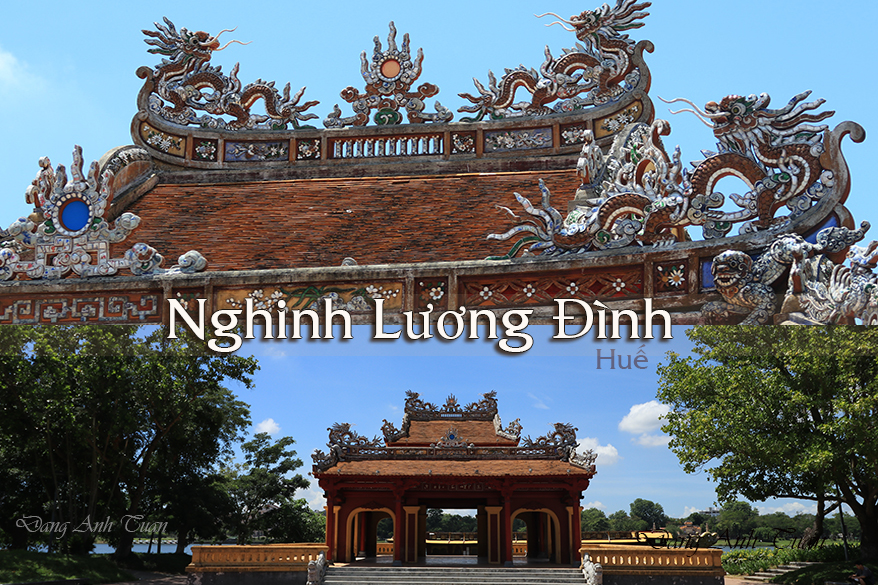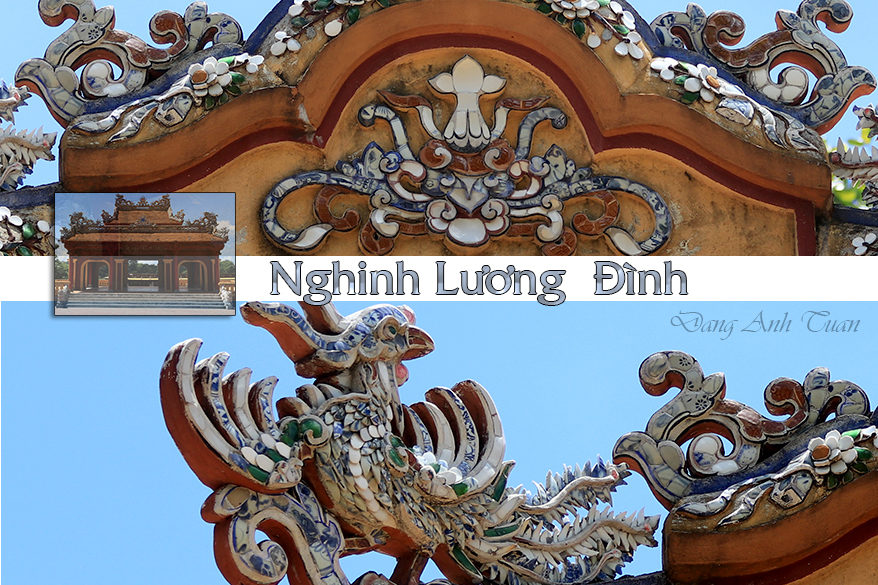Version française
Version anglaise
Galerie des photos
Nghinh Lương đình được xây dựng ở bờ bắc sông Hương, trước mặt toà Phu Văn Lâu dưới triều vua Tự Đức vào năm 1852 và được trùng tu lại dưới đời vua Thành Thái nhưng bị cơn bão vào năm 1904 nên công trình bị tàn phá nặng nề. Sau nầy được dưới thời ngự trị của vua Khải Định (1918) được xây dựng lại và kết nối với bến thuyền liền nhau nhưng vẫn giữ chức năng cũ. Đây là nơi nghỉ chân và hóng mát của nhà vua trước khi xuống thuyền rồng để du ngoạn trên sông Hương. Công trình nầy được nằm dài trên trục chính từ Kỳ Đài truớc cửa Ngọ Môn đến Phu Vân Lâu và có một kiến trúc theo kiểu phương đình. Một gian, 4 chái được nối dài ra ở phía trước và phía sau với nhà vỏ cua qua máng xối được cấu tạo từ vật liệu kim loại. Bốn mặt của gian chính giữa đều được để trống. Còn ở giữa bờ nóc của gian chính thì có lưỡng long chầu nhật .
Còn nhà vỏ cua thì ở bờ mái cũng có hình hồi long chầu mặt nguyệt và ở cuối các bờ quyết thì trang trí hình chim phượng. Các vì kèo gỗ được chạm trổ một cách công phu ở trên mặt với các hình ảnh mang các đề tài bát bửu như: tù và, quạt vả, phát trần, lẵng hoa và bầu rượu. Mái nhà chính lợp ngói ống lưu ly vàng, hai nhà vỏ cua lợp ngói liệt men vàng. Nghinh Lương đình được xây dựng trên nền cao khoảng 90 cm cùng bó vỉa bằng gạch vồ và đá thanh. Nơi phiá bờ sông thì có 13 bậc cấp dẫn xuống một hành lang xây sát mặt nước sông Hương. Nghìn Lương Đình là một trong hai công trình kiến trúc cùng Phu Văn Lâu không có nằm ở trong Đại Nội. Tuy nhiên hai công trình nầy được mọi người ở Việt Nam đều biết đến luôn cả du khách ở nước ngoài vì hình ảnh của nó được in trên tờ giấy 50.000 đồng Việt Nam.
Le pavillon Nghinh Lương a été construit devant Phu Văn Lâu (pavillon des Édits) sur la rive nord de la Rivière des Parfums sous le règne de l’empereur Tự Đức en 1852. Puis il a été restauré à l’époque de l’empereur Thành Thái . Puis il a subi des dégâts importants lors de la tempête en 1904. Plus tard, sous le règne du roi Khải Đinh (1918), il a été reconstruit presque entièrement et relié à l’embarcadère tout en gardant son ancienne fonction. C’est le lieu de repos et de détente de l’empereur avant de prendre une excursion en bateau sur la rivière des Parfums. Cet ouvrage architectural est situé sur l’axe principal de la tour du mât (Kỳ Đài) située en face de la porte principale Ngọ Môn jusqu’au pavillon des Édits (Phu Van) et possède une architecture du style de la maison communale. Une grand espace entouré de 4 appentis, se prolonge en avant et en arrière par des maisons « en coquille de crabe » au moyen des gouttières de drainage en matériau métallique. L’espace central ne possède aucune porte sur ses quatre côtés. Par contre au milieu de son arête faitière, on voit apparaître un globe enflammé (foudre) vers lequel les deux dragons tournent la tête.
Quant à la maison en « coquille de crabe », sur le toit, on retrouve également un couple de dragons rendant hommage à la lune et l’ornement d’un phénix au bout de ses extrémités. Les fermes de toit en bois sont minutieusement sculptées sur leur façade avec des motifs représentant la série des huit joyaux: corne, éventail en forme de feuille de figuier, époussette, panier de fleurs et calebasse à vin.
Le toit principal est recouvert de tuiles « Yin et Yang » jaunes et les deux maisons en coquille de crabe ont leurs tuiles vernissées jaunes. Le pavillon Nghinh Lương a été construit sur une plate-forme d’environ 90 cm de haut avec les dalles de trottoir en pierre « thanh ». Au bord de la rivière, il y a 13 marches facilitant la descente vers un couloir construit près de la surface de l’eau de la Rivière des Parfums. Le pavillon « Nghinh Lương » est l’une des deux œuvres architecturales avec le pavillon Phu Van, qui ne font pas partie de la Cité pourpre interdite. Pourtant, ces deux joyaux architecturaux sont connus de tous les gens y compris les touristes étrangers au Vietnam car leur image est imprimée sur le billet de 50 000 VND.
Nghinh Luong Pavilion was built on the north bank of the Huong River, in front of the Phu Van Lau building during the reign of King Tự Đức in 1852 and was restored under King Thành Thái’s reign. However, it was severely damaged by a storm in 1904. Later, during the reign of King Khải Đinh (1918), it was rebuilt and connected to the adjacent boat dock but still retained its original function. This was the resting and cooling place for the king before boarding the dragon boat to cruise on the Huong River. The structure lies along the main axis from Kỳ Đài in front of Ngo Mon Gate to Phu Van Lau and features a pavilion-style architecture. It has one main hall and four wings extended at the front and back with crab shell-like houses connected through gutters made of metal materials. All four sides of the central hall are left open. In the middle of the ridge of the main hall, there is a motif of two dragons chasing the sun.
As for the crab shell houses, the gable ends also feature dragon motifs facing the moon, and at the ends of the ridge beams, phoenix bird decorations are displayed. The wooden rafters are intricately carved on the surface with images featuring the eight precious symbols such as a conch shell, fan, fly whisk, flower basket, and wine gourd. The main house roof is covered with yellow glazed tube tiles, while the two crab shell houses are covered with yellow glazed flat tiles.
Nghinh Luong Pavilion is built on a platform about 90 cm high, bordered with brick and Thanh stone edging. On the riverbank side, there are 13 steps leading down to a corridor built close to the surface of the Perfume River. Nghinh Luong Pavilion is one of two architectural works, along with Phu Van Lau, that are not located within the Imperial City. However, these two works are well known by people in Vietnam and even foreign tourists because their images are printed on the 50,000 Vietnamese dong banknote.


